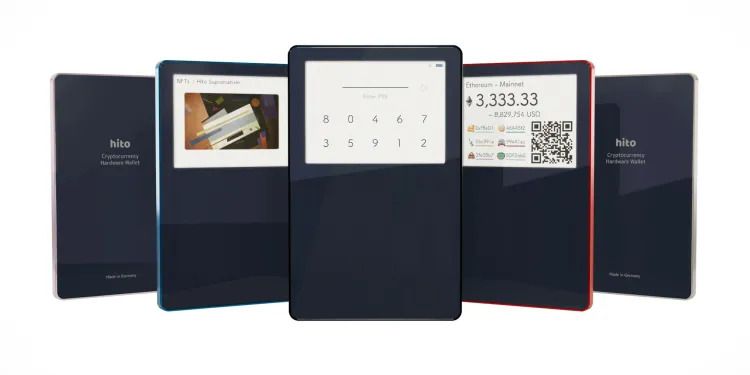Hardware Wallets Are Becoming a Crypto Must-Have in 2023

The fear around custodial wallets reached a fever pitch late last year. With FTX’s dramatic collapse, the entire ecosystem rediscovered the value of the old adage “not your keys, not your crypto.”
Custodial wallets are wallets that the user does not have complete control over. A third party, like an exchange, will hold the private keys. This is crucial if the organization controlling your custodial wallet becomes defunct or gets hacked. Non-custodial wallets add an added layer of protection, as you retain ultimate sovereignty over your crypto.
It is not just illegal activity and poor management that puts your custodial crypto wallet at risk. If anything, hacks should be your biggest concern. Black hat hackers looking for a payday are tempted by the billions of dollars locked up in the most popular exchanges.
The Binance exchange was hacked for $570 million in October 2022, one of the most high-profile attacks in cryptocurrency history. BSC Token Hub, a cross-chain bridge, was exploited by hackers, resulting in the creation of extra Binance Coins (BNB) and the withdrawal of 2 million BNB.
FTX suffered an attack that took hundreds of millions shortly after it declared bankruptcy. Although, that particular exploit remains shrouded in mystery and suspicion. Many members of the community still remain unconvinced that it was a genuine exploit.
Late 2022 Was A Boom Time For Hardware Wallets
The crisis of confidence in custodial wallets has not been bad for everyone. It is no surprise that the hardware wallet industry has grown as more traders and holders seek to secure their funds.
Trezor, one of the two industry leaders, saw traffic jump to more than 350% in the days after the FTX bankruptcy. In the days before, the company’s sales had more than tripled.
Hito, a hardware wallet that offers users wireless charging and NFC, is another that has seen significant growth. “There’s been an industry-wide uptick. Ledger has doubled revenue the first month after FTX collapse, and Ledger has announced a partnership with Binance just before the collapse of FTX,” said Mikhail Kirillov, CEO of Hito.
“Although Hito announced its presale less than six months ago, we can report a trend of sales doubling month over month since the FTX collapse.”

Hardware wallets are also closer to how Bitcoin was intended to be used. Satoshi Nakamoto, the mysterious inventor of Bitcoin, intended it to remove third-party middlemen. “With e-currency based on cryptographic proof… money can be secure and transactions effortless.”
The devices themselves come in a variety of shapes and sizes. The smallest of them, like the Ledger Nano series, resembles a USB Drive and can hang on your keychain. Some of the largest, like the NGRAVE ZERO or the ELLIPAL Titan, are closer in size to a small phone. They all come with different features, such as dust protection or easy-to-use UIs.
Hardware wallets are a subsection of what is known as “cold storage.” A way of keeping your crypto somewhere unconnected to the internet. Not all cold storage requires a device separate from your phone or computer. Software custodial wallets like MetaMask offer a cold storage version for extra security.
Hardware Wallets Aren’t The Only Solution
Not everyone is a fan of hardware solutions. Last month, CZ, the CEO of Binance — the largest centralized exchange — said, “for most people, for 99% of people today, asking them to hold crypto on their own, they will end up losing it.” Since most hardware wallet manufacturers attribute their existence to the failures of centralized exchanges, this is not surprising. But is he correct?
“Time will tell,” continues Kirillov. “But with $70 billion in losses just from the collapse of Celsius, Terra, and FTX alone, it seems asking people to hold their crypto in custodial exchanges is far more risky than losing a device (which doesn’t matter anyway). When it comes to custodial exchanges, “not your keys, not your crypto” is the inevitable lesson [that] users are tired of learning the hard way.
“Lose your device, no problem; as long as you keep your seed phrase backed up, a user can safely restore access to their funds. Yes, we think it’s time users had the tools to trust themselves over custodial exchanges. Hito is one of the easiest tools they can choose to use.”
There are software wallet alternatives that also give you control over your crypto. Projects like Atomic Wallet allow your crypto to sit safely on your desktop. In recent months, Zerion and Frontier have announced easy-to-use browser extensions that are designed to work across multiple chains and with different kinds of digital assets (including NFTs.)
Many software solutions are designed to work with hardware wallets, so it’s not always an either/or situation.
Use a DEX!
If all else fails, decentralized exchanges (DEXs) allow you to swap your crypto while remaining in charge of your keys. If you’re more of a trader than a holder, this is often the best solution. “DEXs (decentralized exchanges) are not the same as Centralised exchanges like Coinbase and Binance,” says Ravindra Kuma, founder & CEO of Frontier.
“Centralized exchanges hold your assets for you, and you have to verify your identity with them before trading. Decentralized exchanges don’t ask for KYC (know your customer), they don’t require an account, and they let you connect to other people’s wallets directly in order to trade.






 Bitcoin
Bitcoin  Ethereum
Ethereum  Tether
Tether  USDC
USDC  TRON
TRON  Dogecoin
Dogecoin  Cardano
Cardano  Bitcoin Cash
Bitcoin Cash  Chainlink
Chainlink  LEO Token
LEO Token  Stellar
Stellar  Monero
Monero  Zcash
Zcash  Litecoin
Litecoin  Hedera
Hedera  Dai
Dai  Cronos
Cronos  OKB
OKB  Tether Gold
Tether Gold  Ethereum Classic
Ethereum Classic  KuCoin
KuCoin  Gate
Gate  Algorand
Algorand  Cosmos Hub
Cosmos Hub  VeChain
VeChain  Dash
Dash  Tezos
Tezos  Stacks
Stacks  TrueUSD
TrueUSD  IOTA
IOTA  Basic Attention
Basic Attention  Decred
Decred  Theta Network
Theta Network  NEO
NEO  Qtum
Qtum  Synthetix
Synthetix  Ravencoin
Ravencoin  0x Protocol
0x Protocol  DigiByte
DigiByte  Zilliqa
Zilliqa  Nano
Nano  Siacoin
Siacoin  Numeraire
Numeraire  Waves
Waves  Ontology
Ontology  Enjin Coin
Enjin Coin  Status
Status  BUSD
BUSD  Hive
Hive  Pax Dollar
Pax Dollar  Lisk
Lisk  Steem
Steem  Huobi
Huobi  NEM
NEM  OMG Network
OMG Network  Augur
Augur  Bitcoin Gold
Bitcoin Gold  Ren
Ren